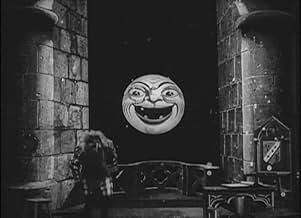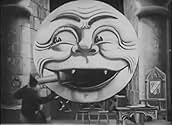IMDb-BEWERTUNG
7,4/10
5146
IHRE BEWERTUNG
Ein Astronom schläft ein und hat einen seltsamen Traum über eine Feenkönigin und den Mond.Ein Astronom schläft ein und hat einen seltsamen Traum über eine Feenkönigin und den Mond.Ein Astronom schläft ein und hat einen seltsamen Traum über eine Feenkönigin und den Mond.
- Regie
- Drehbuch
- Hauptbesetzung
Jehanne d'Alcy
- Phoebe - la bonne fée
- (Nicht genannt)
Georges Méliès
- L'astronome
- (Nicht genannt)
Empfohlene Bewertungen
This is actually a very elaborate fiction film for 1898. Made by Georges Méliès, it lasts over three minutes, when most films during the period lasted about a minute or less. Early cinema historian Frank Gray refers to this film as having consisted of three shots and 60 meters length. Yet, I can't precisely distinguish or separate shots or scenes in it, as the entire film takes place from a fixed framing and long-shot perspective. One could go to either extreme: saying that this is a single shot-scene film since its perspective is stationary, or you could say it consists of dozens of shots, including the trick splices for appearances, disappearances, substitutions and stop-motion animation, which is to say this film is a series of jump cuts.
"The Astronomer's Dream", however, does contain a three-part structure, I'd say. The bookend parts are of the astronomer safe within his laboratory, with the longer, middle part being the nightmare. There are also at least three slightly different decors used: the outer one with the telescope and the entire laboratory; a tighter, less furnished, yet similar one for closer views of the moon during the dream; and, briefly, a wall. Moreover, as indicated by this film having three entries in the Star catalogue, it was available to exhibitors in three parts, which was common then, as films were generally sold in 20-meter lengths. Regardless, this is a sophisticated narrative and production for its time.
The following year, Méliès would produce his first féerie film (fairy film), "Cinderella", which consists of at least four distinct scenes transitioned by dissolves. "Cinderella", albeit, is in the tableau, theatrical style of stationary shot-scenes, but it does distinguish spatially separate scenes for a more advanced narrative construction. One fiction film in 1898, Robert W. Paul's "Come Along Do!" also contained two spatially separate scenes with action continuing across them. "The Astronomer's Dream", however, was Méliès's then most elaborate and sophisticated dream or trick film, although it does contain a fairy godmother type in the goddess Phoebe, who protects the astronomer from attacks by demons, the moon and the rest of the nightmare. It's purely part of what Tom Gunning has referred to as "the cinema of attractions"; the attraction here being the magic or tricks accomplished mostly through substitution splices (a.k.a. stop substitutions), as well as theatrical props and transitions and a brief chalkboard animation within the scene. Today, these trick films hold up well and remain at least amusing because of Méliès's wacky and imaginative humor; their primitiveness is even part of their charm.
"The Astronomer's Dream", however, does contain a three-part structure, I'd say. The bookend parts are of the astronomer safe within his laboratory, with the longer, middle part being the nightmare. There are also at least three slightly different decors used: the outer one with the telescope and the entire laboratory; a tighter, less furnished, yet similar one for closer views of the moon during the dream; and, briefly, a wall. Moreover, as indicated by this film having three entries in the Star catalogue, it was available to exhibitors in three parts, which was common then, as films were generally sold in 20-meter lengths. Regardless, this is a sophisticated narrative and production for its time.
The following year, Méliès would produce his first féerie film (fairy film), "Cinderella", which consists of at least four distinct scenes transitioned by dissolves. "Cinderella", albeit, is in the tableau, theatrical style of stationary shot-scenes, but it does distinguish spatially separate scenes for a more advanced narrative construction. One fiction film in 1898, Robert W. Paul's "Come Along Do!" also contained two spatially separate scenes with action continuing across them. "The Astronomer's Dream", however, was Méliès's then most elaborate and sophisticated dream or trick film, although it does contain a fairy godmother type in the goddess Phoebe, who protects the astronomer from attacks by demons, the moon and the rest of the nightmare. It's purely part of what Tom Gunning has referred to as "the cinema of attractions"; the attraction here being the magic or tricks accomplished mostly through substitution splices (a.k.a. stop substitutions), as well as theatrical props and transitions and a brief chalkboard animation within the scene. Today, these trick films hold up well and remain at least amusing because of Méliès's wacky and imaginative humor; their primitiveness is even part of their charm.
An astronomer (dressed like a wizard) is visited in his observatory by various imps and fairies, and eventually a giant, eye-rolling anthropomorphic moon that eats his telescope, dissolves his umbrella, delivers a couple of frolicking moon-children, and eventually eats the old fellow himself. The entire phantasmagoric night turns out to be a dream (hence the original title ('The Astronomer's Dream'), which was more accurate than the deceptive American release "A Trip to the Moon"). The film is a wonderful showcase for Méliès' early experiments in 'trick photography' and includes a number of well done (for the era) substitution splices as the fanciful characters appear and disappear, and a clever animation scene in where images on the astronomer's black-board come to life. A clever and imaginative fantasy film from the early days of cinematography.
Maybe the first example of science fiction and fantasy in a narrative form from the pioneer of early cinema Georges Melies as he plays an astronomer studying in an observatory when a devil figure appears then a woman who sends the devil away.
The astronomer draws a globe on a blackboard which starts to move, when he looks through the telescope the moon appears with a large face like the face later used in Thomas the Tank Engine cartoons and it eats the astronomer's telescope.
Then small men come through the mouth of the moon and then it goes back in the sky and then the moon becomes a crescent when another figure in the shape of a lady appears.
This is just part of the content in a short film just over three minutes long that has set design, characters in costumes, special effects and use of editing as well as surreal imagery. The editing is jumpy but again it is Melies that was showing the early promise of cinematic illusion.
The astronomer draws a globe on a blackboard which starts to move, when he looks through the telescope the moon appears with a large face like the face later used in Thomas the Tank Engine cartoons and it eats the astronomer's telescope.
Then small men come through the mouth of the moon and then it goes back in the sky and then the moon becomes a crescent when another figure in the shape of a lady appears.
This is just part of the content in a short film just over three minutes long that has set design, characters in costumes, special effects and use of editing as well as surreal imagery. The editing is jumpy but again it is Melies that was showing the early promise of cinematic illusion.
George Méliès makes my mind melt and my jaw drop again! This short film is actually better than the last! It has the extremely cool illusions of people appearing and disappearing out of thin air (still do not know how that was accomplished), but this one steps it up a notch. There's this really creepy moon that eats the furniture that moves on its own and it looks awesome. The guy who is playing the astronomer did a great job. His performance made me laugh. The biggest improvement though is the addition of music. Just simply adding music helps, but it's even better when the music fits perfectly and adds another level of enjoyment to something, which is the case here. This makes me way more eager to check out more of George Méliès work, and I think I can safely say I won't be disappointed.
Astronomer's Dream, The (1898)
*** (out of 4)
aka La Lune a un metre
An astronomer is in his office working when the devil and a woman appear to him and this sets off a strange dream, which includes the moon attacking him. This is another enjoyable film from Meiles as we get to see various magic tricks including the familiar gags of the astronomer going to sit down only to have the chair disappear. What really stands out in this film is the attack by the moon, which is perfectly done and leads to several laughs. I love Melies' design of the moon making it something to fear with its evil eyes and mouth. The special effects are quite nice throughout. This is certainly a good place for newbies to start.
*** (out of 4)
aka La Lune a un metre
An astronomer is in his office working when the devil and a woman appear to him and this sets off a strange dream, which includes the moon attacking him. This is another enjoyable film from Meiles as we get to see various magic tricks including the familiar gags of the astronomer going to sit down only to have the chair disappear. What really stands out in this film is the attack by the moon, which is perfectly done and leads to several laughs. I love Melies' design of the moon making it something to fear with its evil eyes and mouth. The special effects are quite nice throughout. This is certainly a good place for newbies to start.
Wusstest du schon
- WissenswertesWhen this film was imported into the United States by producer Sigmund Lubin in 1899 he re-titled it A Trip to the Moon. However this has no relation to the 1902 film A Trip to the Moon. The original translated title is "The Moon at One Meter's Distance" or freely "The Moon at Arm's Length".
- VerbindungenFeatured in Castle: Punked (2010)
Top-Auswahl
Melde dich zum Bewerten an und greife auf die Watchlist für personalisierte Empfehlungen zu.
Details
- Erscheinungsdatum
- Herkunftsland
- Sprache
- Auch bekannt als
- The Astronomer's Dream; or, The Man in the Moon
- Drehorte
- Produktionsfirmen
- Weitere beteiligte Unternehmen bei IMDbPro anzeigen
- Laufzeit
- 3 Min.
- Farbe
- Sound-Mix
- Seitenverhältnis
- 1.33 : 1
Zu dieser Seite beitragen
Bearbeitung vorschlagen oder fehlenden Inhalt hinzufügen




















